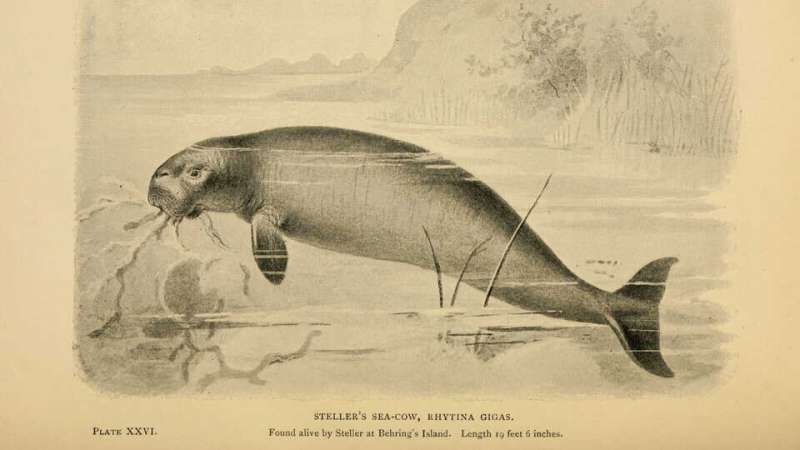
For millions of years, the Steller's sea cow, a four-ton marine mammal and relative of the manatee, shaped kelp forests along the Pacific coast of North America by eating massive quantities of kelp fronds from the upper canopies.
In a paper published today in the journal Frontiers in Ecology and Evolution, researchers from the California Academy of Sciences reveal what historical kelp forests might have looked like in the past.
Kelp forests have high productivity. They act as storm buffers, are important for fishing, and are home to many marine organisms, yet they are in decline throughout the Pacific.
The Steller's sea cow is one of the large marine herbivores that are no longer around. There might be a major component missing when it comes to their decline.
Shifting baseline syndrome is a tendency to evaluate the state of modern ecosystems based on their recent past, which can obscure how anecosystem has existed over a long period of time.
The consequences of this thinking are already being seen with wildfire management. In the short term, wildfires have been seen as something to suppress because of the damage they cause. In the long run, wildfires are a natural part of the systems that can lead to better forests.
Shifting baselines can be addressed with a new approach.
The researchers propose a new way of evaluating the overall health of the environment to avoid the pitfalls of shifting baseline syndrome.

The PPF approach, which combines historical lines of evidence from museum specimens and the fossil record with Indigenous traditional ecological knowledge and modern scientific data, can lead to mathematical models that are more accurate depictions of natural systems. These models can be used for more effectiveConservation.
"We are surrounded by severely degraded ecosystems, places that were far healthier a century ago, let alone a millennium or more," says study author and Academy Executive Director Scott Sampson, PhD.
Even if we protect them, many of them are in danger of collapsing. If we are to help guide a place towards a flourishing future, we need to understand not only its current state of health, but past states as well. The Past-Present- Future approach to conserve has the potential to be revolutionary.
The "sea cow effect" is being uncovered.
A better baseline from which to compare against the state they are in today and predict how they might change in the future is what the researchers wanted to achieve.
The researchers first input the effects different players in the system have on the forest. The model was compared against pre-existing data to make sure it replicated how the ecosystems work.
After refining the model, the researchers were able to see how the Steller's sea cow impacts the forest over time.
One of the more important and surprising findings was that the Steller's sea cow resulted in a completely different type of forest. The sea cow's presence in the upper canopy would have resulted in more of a balance between the two plants as more sunlight would have reached the sea floor.
The current state of the kelp forests is heavily degraded due to overpredation from sea urchins. She says algae could provide an additional food source for urchins.
The study showed that when the sea cow was present, the kelp forests as a whole were often more resilient: Even under adverse conditions, such as ocean warming or disease outbreak, the forests may have been less likely to transition to the barren urchin-dominated state that is often seen today. The researchers dubbed this effect the "sea cow effect."
Experiments on test plots would allow us to model the efficacy of different interventions in order to build more resilience into kelp forests. In order to recreate the role that was lost with the Steller's sea cow, it is necessary to harvest the upper fronds.
The impact of the extinct megaherbivore Steller's sea cow (Hydrodamalis gigas) on the resilience of the forest was studied. 10.389/fevo.
Journal information: Frontiers in Ecology and Evolution